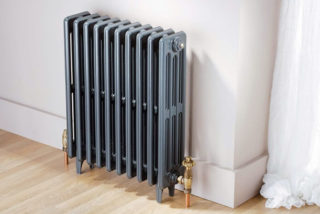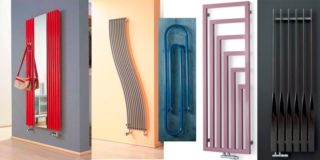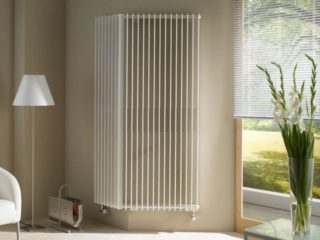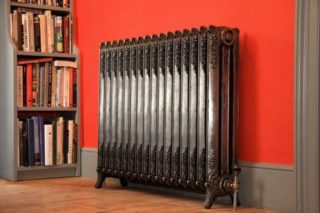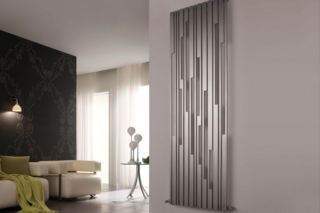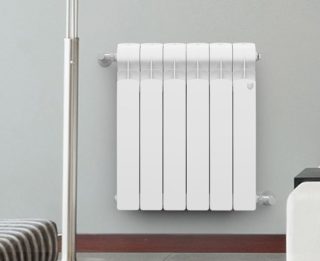When choosing reliable in use and convenient to use heating batteries, the main attention is paid to the efficiency of their work. Among the proposed samples, the currently popular vertical radiators stand out, significantly differing from the horizontal models. Before buying thermal products of this class, it is advisable to familiarize yourself with their design.
Design features
The main difference between vertical batteries and horizontal products is their non-standard sizes, according to which the width of the radiator is less than its height.
If ordinary batteries are traditionally installed in a niche under the windows, then their vertical counterparts can be placed on the walls in any convenient place of the apartment. They are allowed to be mounted in free niches, openings of rooms or in rooms where there are no windows at all. According to the main parameters, wall radiators do not differ significantly from horizontal models, since they are made of the same materials. This is traditional cast iron, as well as the following common metals:
- steel;
- aluminum rolling;
- combination of steel and aluminum.
In addition, they are identical in their structure and can be sectional, panel, as well as tubular. By the method of connection to the central heating system, they are divided into products of diagonal, side and bottom connections.
The difference between vertical radiators and familiar models is the original design performance, combining a wide variety of color shades and shapes. This advantage allows you to install them even in the front corners of a modern apartment.
In what cases are applied
Given the characteristics of the vertical heating devices, they are preferable to use in the following cases:
- it is required to save on the occupied space in small premises (including loggias combined with the room);
- it is necessary to heat areas with panoramic glazing occupying a wall from floor to ceiling;
- in rooms completely devoid of windows: in bathrooms, hallways or in small dressing rooms.
In addition, they are allowed to be used as a decorative element of the interior in the arrangement of residential premises.
It is important to consider situations when a wall-mounted vertical radiator is not suitable for installation and operation in specific conditions:
- the owners plan to mount radiators on the walls (interior partitions) from plasterboard blanks without additional reinforcement;
- with insufficiently insulated outer walls;
- in low rooms, the small volume of which makes convection of air difficult.
In most situations, vertical radiators are purchased in order to create a unique design in the house, despite the significant costs of their purchase.
Advantages and disadvantages
Among the advantages of high heating batteries are the following:
- saving living space in the room, due to the small dimensions of the heating device;
- increased heat transfer associated with a significant area of the surface radiating heat;
- the possibility of using it not only for its intended purpose: as a basis for drying towels, for example, hangers or an original frame for a mirror;
- permissible operation of the battery while decorating the surrounding spaces;
- an opportunity to do without decorative lattices.
The undoubted advantage of relatively high radiators is the simplicity of their installation, as well as the subsequent maintenance.
The disadvantages of vertical radiators are:
- a relatively low heat transfer, due to the uneven heating of the upper and lower parts of the device;
- the need to prepare a reliable base for fastening - this is due to the significant weight of the heating structure;
- the need for insulation of the outer wall on which the radiator itself is installed;
- difficulties with the installation of batteries with side (diagonal) eyeliner.
The last inconvenience is explained by the need for covert pipe laying, which otherwise noticeably spoils the appearance of the heated rooms.
The disadvantages of heating systems of this type also include some difficulties with the control valve air bleed and a relatively high cost.
Material selection
The main feature that allows you to classify vertical heating radiators is the source material from which each of the products in question is made. In accordance with this criterion, they are:
- from cast iron or steel;
- aluminum;
- bimetallic;
- based on copper and plastic (extremely rare).
Cast iron batteries
Cast iron heating batteries are among the classic designs that were widespread in past centuries. They are still in demand by the consumer, which is explained by their following advantages:
- product strength;
- relatively low price;
- durability.
On the other hand, this material has a number of significant drawbacks that have forced manufacturers to master the production of modern samples based on more "advanced" materials:
- the difficulty of installation, due to the significant weight of the mounted systems;
- fragility of cast iron material, inability to withstand shock loads;
- low thermal conductivity, forcing to artificially raise the temperature of the coolant.
If you need to heat cast-iron batteries to around 45 degrees, the water temperature in them will have to be raised to 70 degrees. As a result, there is an overspending of energy resources, especially noticeable during the heating season in private suburban buildings. Therefore, for the private consumer, the problem of savings is crucial when choosing the material of a heating device.
Aluminum products
The vertical tubular radiator based on aluminum looks much more attractive than cast-iron samples of the same class. In addition, the thermal conductivity of such heating elements is much higher.
Before buying aluminum batteries for a private home, please note that they are sensitive to the quality of the water coolant. If the supplied liquid is very dirty, and there are no filters at the system inlet, it is undesirable to use them in private homes. Without special cleaning of the carrier, aluminum radiators will quickly fail. On the other hand, the installation of filter elements will require additional costs. Their disadvantages also include the inability to operate at high water pressures.
Steel radiators
Steel batteries are a typical example of "advanced" heating systems having two different designs: tubular and panel. The latter option is positioned as a budget and the heat transfer is somewhat inferior to tubular products. On the other hand, such radiators are unpretentious in operation and are in demand in private homes where additional filtering of the coolant is not provided.
Unlike panel samples, tubular steel batteries are categorized as elite models with the following advantages:
- high level of thermal return;
- profitability;
- attractive design;
- durability (declared by the manufacturer operating life - about 25 years).
Due to its attractiveness, tubular radiators are often used as an element of decorative decoration of a living room.
Among the models of this class, steam heating batteries made of stainless steel stand out.
Steel batteries in comparison with products from other materials have a definite advantage, since their heat transfer is much higher.
Bimetal radiators
Bimetallic radiators stand out as a separate group, which are a worthy choice for any residential premises. They are made of two metals. As the supporting base, they use steel pipes on which aluminum ribs are mounted on top.
Combined radiators have a number of advantages:
- Long service life - according to the manufacturer, they reach 30 years.
- The core is made of high carbon steel, thanks to which the bimetallic radiator has received the necessary strength.
- High level of heat transfer - up to 190 W per section.
- A wide selection of items that are distinguished by their design and color.
A temperature regulator is provided in the standard set, allowing you to change the heat transfer in a wide range.
The disadvantages of the combined products:
- direct contact of two metals having different expansion coefficients leads to the appearance of extraneous sounds during the operation of a bimetallic radiator;
- small sizes of the inlet and outlet pipes often cause clogging, especially if there are a large number of foreign particles in the coolant.
- the need for installation at the input of the filter element.
The relative disadvantages of these radiators include their high cost.
Features of individual connection types
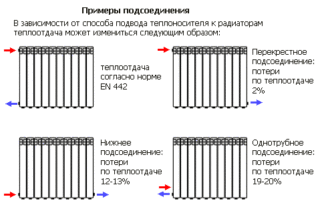 All heating radiators, including the vertical version, can be connected in two ways: from the side or from the bottom of the case. With the option of lower connection of the inlet and outlet nozzles, as a rule, no questions arise. When organizing it, from one side, the coolant is supplied from below to the radiator, on the other, it is diverted. With the lower connection, it does not matter which wiring diagram is used - single-pipe or two-pipe.
All heating radiators, including the vertical version, can be connected in two ways: from the side or from the bottom of the case. With the option of lower connection of the inlet and outlet nozzles, as a rule, no questions arise. When organizing it, from one side, the coolant is supplied from below to the radiator, on the other, it is diverted. With the lower connection, it does not matter which wiring diagram is used - single-pipe or two-pipe.
With side wiring, the number of connection methods, especially in the case of two-pipe wiring, increases. The following options appear:
- diagonal connection;
- one way connection;
- seat inclusion.
The first of these methods is considered the most suitable in terms of the efficiency of the heating system. All other connection options do not guarantee the desired level of heat transfer.
